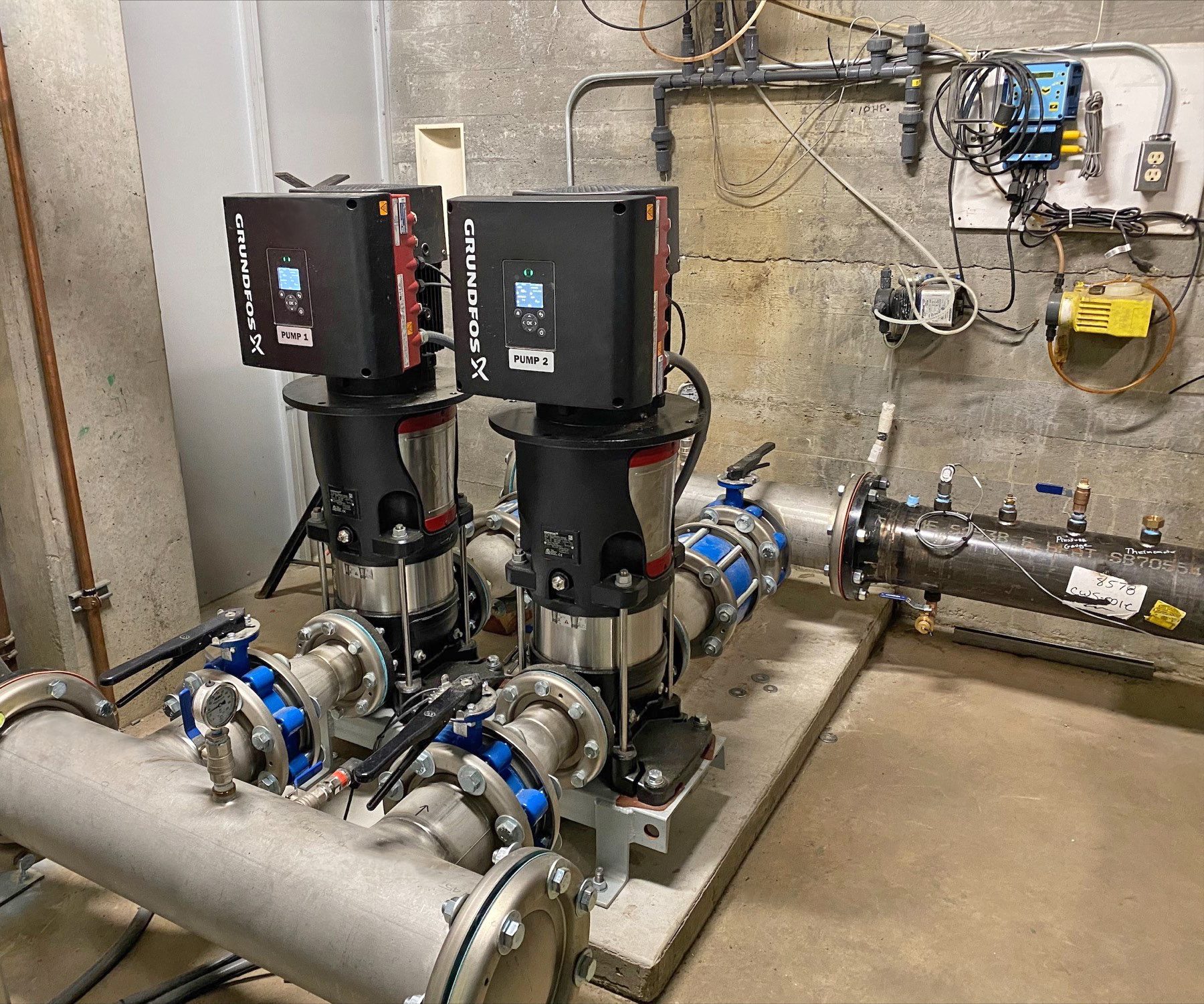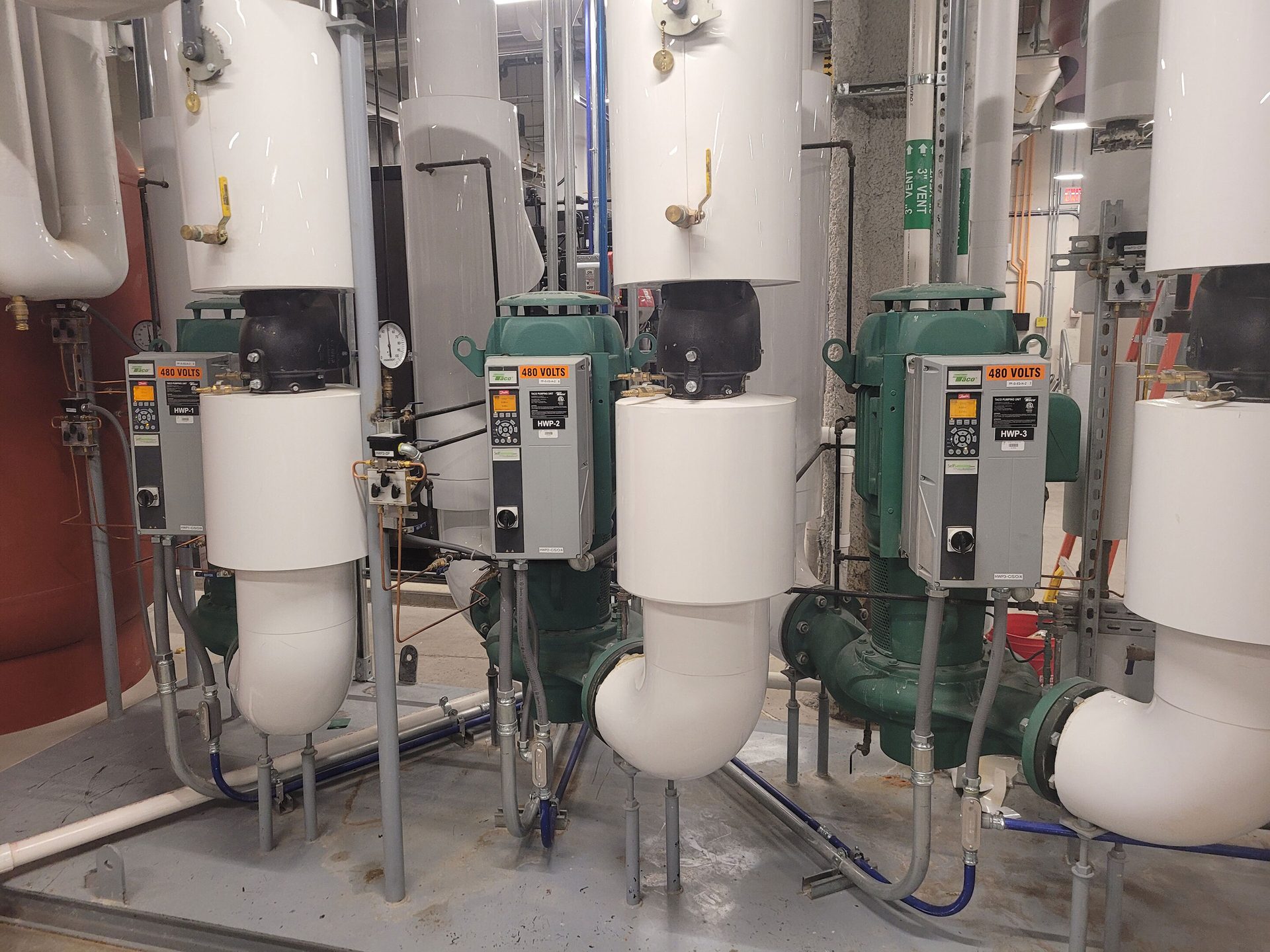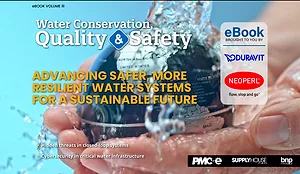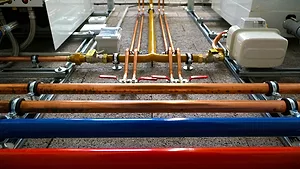Flowing forward: commercial pumps embrace sustainability for a greener future
April 1, 2024
Flowing forward: commercial pumps embrace sustainability for a greener future
April 1, 2024Armstrong Fluid Technology's David Lee notes that properly sizing pumps is important for sustainability. "Pumps that are improperly sized may never perform properly to provide the flow levels required by other system components, and will likely operate outside of their range of best efficiency." | All Images courtesy of Armstrong Fluid Technology, Grundfos, Taco Comfort Solutions and Xylem.
As the world increasingly shifts its focus towards sustainability, the role of plumbing engineers in implementing eco-friendly solutions becomes even more critical. One of the foremost trends in commercial pump technology is the emphasis on efficiency and energy conservation. With growing concerns about environmental impact and rising energy costs, manufacturers are constantly innovating to develop pumps that consume less energy while maintaining optimal performance.
Article Index:
“Pumps are the heart of a good system design,” notes Mark Chaffee, vice president of governmental affairs and product management, Commercial and Industrial, Taco Comfort Solutions. “In today’s commercial buildings, there is a greater push for total system integration to address the trends for beneficial electrification, space flexibility and utilization, resiliency and energy efficiency. This results in system designs that can be efficient today and flexible for the future; this is easiest to do with a hydronic-based system controlled by smart, flexible, self-sensing pumps.”
Beyond the U.S. Department of Energy’s (DOE) minimum efficiency standards for pumps, Pete Korzeniewski, CBS Global Business Development, Grundfos, doesn’t see too much coming in the near future in terms of hydraulic innovation.

According to Grundfos' Pete Korzeniewski, the real bang for the buck in terms of pump efficiency comes with variable speed drives and controls.
“Beyond that, the next big thing is the motor,” he says. “Grundfos has been developing ECM or permanent magnet motors for the last 20 years. We're improving our materials so that there's less environmental impact for sourcing those materials. That is dramatically improving the motor efficiencies that are available. We’re a European company, so we’re governed by the EU, which is a little further ahead of the U.S. in regards to regulations — we’re eight to 10 points more efficient than NEMA Premium. Our internal corporate guidelines are to build motors to IE5 efficiency, which if you look at NEMA and where we are today with NEMA Premium, NEMA is equivalent to IE3. The products that are coming from Grundfos, and others as well, are one or two steps beyond where NEMA is today. NEMA does have an unofficial category called Super Premium. That would be IE4. They don't have a name, even unofficially, for where we're manufacturing motors today.”
Korzeniewski adds that the real big bang for the buck comes with controls.
“Once you’ve got a pump that’s as efficient as you can get it, now you tie all that together because anything you’re doing with water or fluids within the building, there’s a variable load,” he explains. “Particularly in the heating and cooling systems, we design these systems for the coldest day of the year or the hottest day of the year, but ASHRAE would tell us that we're spending 80% to 90% of our time operating at a part-load condition. How do we manage that part-load condition? Well, we do that with variable-speed drives and advanced controls.”
According to David Lee, offering manager — NPI, Armstrong Fluid Technology, there is a continued progression in the uptake of relatively new capabilities for pump connectivity and performance tracking subscription services.
“Digital tracking of pump performance and status adds value to maintenance protocols and supports Active Performance Management of system efficiency,” Lee says. “The key is combining and integrating all of the available advancements to deliver the best results for a given building. The integration of high-efficiency pump hydraulics, high-efficiency motors, smart controls and cloud analytics is the only way to achieve impactful and consistent carbon reduction in mechanical room equipment operations.”
Looking for a reprint of this article?
From high-res PDFs to custom plaques, order your copy today!


Xylem's Stephen Clark says, "“Smart pumps with integrated variable speed drives and synchronous motors offer precise control over water flow while optimizing energy consumption based on real-time demand making them a sustainable choice for commercial buildings seeking environmentally friendly solutions.”
Lee also notes it’s important for engineers to properly size a pump in order to maximize a building’s efficiency.
“Though they may not be the largest user of energy, pumps represent a significant percentage of energy use both within the HVAC system and the overall building,” he says. “Pumps that are improperly sized may never perform properly to provide the flow levels required by other system components, and will likely operate outside of their range of best efficiency. Proper pump operation and real-time adjustment to changing flow demand impacts overall system performance. This is the area where intelligent pumps provide a significant energy reduction and help reduce environmental impact.”
Xylem’s Director of Intelligent Solutions Stephen Clark points to smart pumps as a new technology with both sustainability and serviceability in mind.
“Smart pumps with integrated variable speed drives and synchronous motors offer precise control over water flow while optimizing energy consumption based on real-time demand making them a sustainable choice for commercial buildings seeking environmentally friendly solutions,” he says.
Optimization and integration
When it comes to pump optimization and integration, Chafee notes that system designers are encouraged to begin by using a pump manufacturer’s software to select the most efficient pump possible at the desired operating point of the system.
“Then they need to make sure that the pump is supplied with a variable speed drive technology that includes an integrated control strategy (like self-sensing) but also has the additional options (like Delta-T control) that also help to assure optimal efficiency and operation of other system components,” he says. “The next step is to integrate the system’s design and operation with a building management system (BMS) for communication with pumps and other components. This can provide an additional level of diagnostics, reporting and metrics tracking to show the lifecycle savings that are achievable by having a system, with pumps at the heart of it, working in harmony to provide the right balance between operational efficiencies, occupant comfort, and reliability.”
Smart pumps provide multiple connectivity protocols for connecting the pump to the BMS, Clark explains.

Taco's Mark Chaffee notes that engineers and installers need to gain confidence in this smart pump technology, its operation, and ability to deliver savings across a pump’s lifecycle.
“This helps monitor how the pumps are performing, ultimately leading to better energy performance,” he says. “Utilizing condition monitoring helps to prevent failures before they happen, leading to an overall more sustainable system. Optimyze Condition Monitoring solution provides health guidance and predictive maintenance advice for rotating and fixed assets such as pumps, motors, heat exchangers and steam traps. It periodically monitors system vibration, temperature and pressure, sharing data for remote monitoring through the simple-to-use mobile applications for iOS or Android. Optimyze provides condition monitoring of mechanical and electrical assets through periodic vibration and temperature measurement. This testing enables predictive analysis to identify potential problems with equipment before they occur, helping to manage system reliability and maintenance.”
The entire point of optimization and integration is ultimately occupant comfort, Korzeniewski says.
“In our industry, our first point of contact is with the consulting engineer, because they’re designing the building,” he says. “As we’ve talked with chiller manufacturers about how we propose setting up the chilled water system and using a distributed pumping strategy versus a large central plant strategy, they get it right away. They can see that if we're optimizing the flow through any particular air handler, having the heat transfer we're looking for at each of those air handlers, we're going to have a positive impact back in the mechanical room with the chiller itself. They want that from an optimization standpoint, but one of the biggest benefits is that we are providing comfort within the building. Occupant comfort is a symptom of your system not being optimized, not being sustainable. When your occupants are comfortable, they're not complaining. If they're not opening windows in the middle of the winter or having heaters under their desk in the middle of summer, now you know your system is working the way that you want it to work.”
Pump design trends
According to Rajni Suthar, director of new product development and OEM engineering for Xylem, there are several emerging trends and pump design/application developments that engineers need to be aware of that further enhance sustainability efforts in commercial buildings.
“Some of these trends include smart building automation; data-driven sustainability; energy storage solutions; and predictive maintenance,” he says. “The integration of more automated utilities can significantly improve performance and cut operational costs over time. There is an increasing focus on the collection, management and analysis of environmental and sustainability data to meet ESG targets and other regulatory requirements. Implementing energy storage solutions to optimize renewable energy technologies can help make buildings more self-sufficient and reduce energy costs. And by relying on predictive maintenance instead of a reactive break-fix approach, building owners can identify hidden energy waste, resulting in more efficient building management.”

Korzeniewski notes the DOE minimum efficiency standard is driving adoption of smart pump technology.
Korzeniewski notes that engineers need to think differently about how they select pumps.
“There have been a lot of changes in recent years,” he says. “We've put a variable frequency drive on the pump because we know the pump has a variable volume flow that it needs to manage, but we're still picking the flow and head requirement for that pump based on a worst-case scenario, that hottest day of the year or coldest day of the year. Don't pick the pump that's most efficient at 100% of your load. Pick a pump that is most efficient at 50% of your load, because pumps have limited turndown. You can't take a pump that is designed to be efficient at 1,000 gallons a minute and effectively run it efficiently at 100 gallons a minute. The machine's not capable of doing it. If you pick a pump that's capable of operating efficiently at 300, 400 or 500 gallons a minute, then it's going to work really well at 100 gallons a minute. Then you put multiples of those pumps together so that you have all of the pumping capability that you need for that worst-case scenario. Then you're not punishing yourself for selecting inefficient equipment to do your everyday work.”
Chaffee points out that hydronic system designs also extends to piping design to gain great efficiencies while reducing total materials and labor needed on job sites.
“To ease design integration, Taco offers our Hydronic System Solutions (HSS) software,” he says. “HSS is a unique, dynamic interactive HVAC systems building software that works in the same way that you think. Imagine connecting a heat pump and back-up boiler combination to a coil in a few easy steps while the software sizes all of the pipes and pumps and performs literally hundreds of calculations in seconds. The software takes system designers from innovative design concepts to building loads to scheduling equipment with ease and reliability. To drive innovation into your next design, the software can easily layout Taco LoadMatch and Williams Integrated Piping Systems (IPS) which takes sustainability design efforts to a whole new level. These systems deliver improved comfort, greater operational control, lower installation costs, reduced material usage, simpler maintenance and significant energy savings.”

Taco Comfort Solutions offers its Hydronic System Solutions (HSS) software to help engineers ease design integration.

Lee explains the fluid flow requirements of HVAC and plumbing systems in commercial buildings can be met more efficiently when pumps are provided as part of a complete packaged system.
“We continue to see a majority of buildings designed and constructed using a ‘stick build’ approach for the assembly of mechanical systems,” he says. “Everyone in the value network is better served when the different components of a system can be selected, procured, assembled and tested in a factory environment before being delivered to the site in one package, ready for connection. The latest pump designs are optimized to operate at higher speeds using Ultra-Premium Efficiency motors and integrated controls. This reduces both the pump size and the overall weight for reduced embodied carbon as well as operational carbon.
Adopting smarter technologies
According to Korzeniewski, the DOE minimum efficiency standard is driving adoption of smart pump technology.
“Whenever you’re pulling out an old pump and putting a new one in, the DOE is regulating minimum efficiencies, so it’s driving people toward this technology,” he says. “There’s been tons of incentives — starting in Vermont and California, but now there are rebates all over the country. We’re starting to see more mass adoption of this equipment.
“From a consulting engineer standpoint, one of the issues with the idea of putting smaller smart pumps into the building as opposed to big central pumps is that people view pumps as a maintenance-heavy item,” Korzeniewski adds. “We have labor shortages and things like that, so there's less and less people who can take care of those things. But these are advanced, maintenance-free designs. Our small smart pumps are wet rotor pumps. They don't have mechanical seals. They don't have bearings. There's no wear parts. That's a 20-, 25-year pump when you put it in. There's nothing that's going to fail.
It's thinking of a pump more like someone would think of a small fan ... and fan wall technology is a great comparison to what we're trying to do with these small smart pumps — these are very reliable pieces of equipment. You put them in, and they're going to last most likely the lifetime of that system.”
Korzeniewsi notes that Grundfos has a lot of current initiatives around training. “We've just opened our Sustainable Buildings Academy. It's a training center at our brand new headquarter building in Brookshire, Texas, outside of Houston. We're not calling it the Grundfos Sustainable Buildings Academy. It's just the Sustainable Buildings Academy. We want to teach people how to use these technologies. I think the technologies have been on the market for a while now. They were adopted slowly at first. The adoption rate is starting to pick up and people are now using them quite regularly, but they're not changing the system design or their process for how they select equipment. I think that's the next challenge for us, is helping people better understand these technologies in the applications that they're designing systems for, and now you'll start to see the extraction, the potential optimization associated with these types of equipment. It's that training effort now that we're putting our resources into for the next few years.”
Chaffee agrees, saying it all starts with education.

One of the most forceful drivers of getting energy efficient smart pumps included in new projects is the Federal Infrastructure Act, Chaffee notes.
“Engineers and installers need to gain confidence in this smart pump technology, its operation, and ability to deliver savings across a pump’s lifecycle,” he says. “They also need experience working with the controls to reliably integrate them into systems to deliver superior comfort. Taco has been at the forefront of this training effort on innovative system designs and self-sensing pumping. We’ve also partnered with organizations like NEEA to help spread the word and develop utility incentive programs to increase market adoption.
“Other partners include the Hydraulic Institute’s Pump Systems Matter program that provides the marketplace with training, tools and collaborative opportunities to progress sustainability practices into normal business operations,” Chaffee continues. “A great resource if you’re looking to assess your current pumping system and provide recommendations to improve its operation is to seek out an HI certified Pump System Assessment Professional (PSAP).”
Additionally, one of the most forceful drivers of getting energy efficient smart pumps included in new projects is the Federal Infrastructure Act, Chaffee adds.
“The Act is pumping billions of dollars into all sorts of federally-funded building projects, from government buildings and schools to clean water and drinking water infrastructure,” he says. “Written into this Act is a 10% green infrastructure set-aside that specifically calls out energy efficient pumps and pumping systems as qualifying equipment. This not only provides significant federal funding but ties together the work of the Hydraulic Institute’s Energy Rating program along with local utility and state incentive programs that reference the ratings, encouraging all entities to push for the selection and adoption of the most energy efficient pumps. This has the potential to unlock savings of 14.2 million megawatt hours annually or the equivalent over a pump’s lifetime of the annual electrical consumption for more than 13 million homes.”
Lee notes that the greatest barrier for adoption is cost. “Operating commercial buildings is a very difficult responsibility in a market environment. Building owners are profit-oriented, so the decision-makers in those firms are focused on generating and protecting shareholder returns. In the face of market forces, it is challenging to persuade people to look beyond the standard two-year time frame for payback on capital investments. Where investments in sustainable solutions provide long-term energy savings, they are definitely attractive, but for anyone focused on a short-term financial timeframe, the value might be difficult to see.”
Clark agrees, noting the initial costs associated with implementing these solutions are often a barrier when compared to traditional alternatives such as single-speed drives. “One significant obstacle is the higher upfront investment required for adopting the latest technology. However, it’s crucial to look at the long-term benefits and cost savings, such as reduced operational costs over time, as well as the economic advantages of increased energy efficiency.
“Hydronics have been around a long time and have a proven track record that typically sustains hydronic system equipment for 20 to 30 years or more,” he adds.










